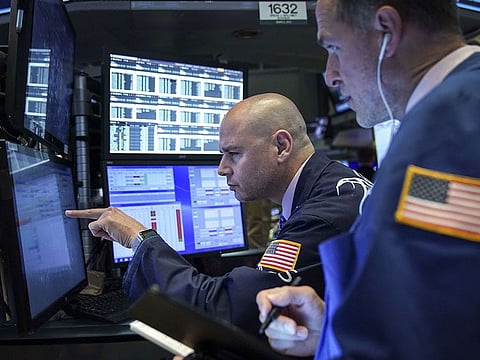With two tweets, Trump shatters historic calm in global markets
Assets across the globe were swept up by the developments, with volatility index spiking

Singapore: In the end, all it took was two tweets from Donald Trump.
After weeks of warnings from many on Wall Street that price swings across global markets were too subdued, the American president’s threat to boost tariffs on China sent volatility soaring Monday. The VIX Index jumped 43 per cent, the most since October — the start of a horrible quarter for US equities. S&P 500 Index futures slid 1.7 per cent and the Shanghai Composite fell 5.6 per cent, the most since February 2016. European shares also dropped.
Whether they were a negotiating tactic or a sign of something more ominous, Trump’s tweets jolted markets that had been lulled in recent weeks by signs of progress in trade talks, a dovish turn by the Federal Reserve and better-than-expected corporate earnings. Investors who had grown accustomed to cross-asset volatility at or near historically low levels were once again forced to consider that all might not be smooth sailing.
“Trade had been put to the side by many market participants,” Andrew Tilton, chief Asia-Pacific economist at Goldman Sachs Group Inc, said on Bloomberg Television. “Market pricing assumed there would be some kind of a deal, and no further escalation in tariffs. And meanwhile the growth outlook was actually improving.”
Now, “this raises the spectre of a significant hit to growth should these tariffs escalate and should the uncertainty associated with that weigh on investment going forward,” he said.
“It might not be as bad as it looks” but it’s “very likely to undo all of the positive momentum we’ve seen,” said Michael McCarthy, chief market strategist at CMC Markets Asia Pacific Pty in Sydney. The question is whether this is “a last-minute negotiation tactic” or will mark a breakdown in the talks, he said.
Still on?
China reportedly was considering nixing the talks that were scheduled to resume Wednesday in Washington, though the Foreign Ministry said Monday afternoon that negotiators were indeed preparing to travel to the US for the meetings. The ministry declined to provide details on the schedule, however.
Assets across the globe were swept up by the developments. The yuan plunged the most since 2016, catching options traders off guard. WTI crude fell more than 2 per cent, dropping to nearly $60 a barrel. Soyabeans fell, while gold rose. The moves came amid heavy volume, even though Japan, South Korea and the UK are closed for holidays.
Chinese state-backed funds were active in selected stocks, according to people familiar with the matter, seeking to cushion the blow from the sudden escalation in trade tensions.
“If current news flow is simply posturing and relations get smoothed over and a US-China deal is ultimately reached [though probably over a longer time frame than previously expected] CNH could temporarily trade back to 6.75,” according to Jason Daw, head of emerging-market strategy at Societe Generale SA in Singapore. “If it all falls apart and tariffs are raised this week and the two sides stop active dialogue, CNH could easily head to 6.90 in the second quarter.”
CNH, the yuan traded offshore, was recently at 6.7819 per dollar, down 0.7 per cent.
Nomura Holdings Inc strategist Charlie McElligott said it’s possible the S&P 500’s recent run-up to record levels might have given Trump enough confidence “to absorb a market drawdown and again lean into what some in the administration believe is Chinese ‘slow-playing’ — all in an attempt from to extract additional last-minute deal concessions.”
It remains to be seen how US markets might absorb the move in the VIX, after data last week showed hedge funds were shorting the gauge at a record rate. Some have downplayed the significance of that milestone, saying the shorts are offset by longs elsewhere, but for many it brought back memories of the “volmageddon” meltdown of February 2018.
Declines in equities could breed yet a further sell-off thanks to the role of quantitative players.
Moves by commodity trading advisers, or CTAs, could be triggered around 2,879 on the S&P 500, according to Nomura’s McElligott. That level would be about a 2.3 per cent drop from the gauge’s close on Friday. The futures were at 2,896.50 as of 4.26pm in Hong Kong, after falling as low as 2,883.50 earlier. Another “acceleration point where moves could get sloppy” is 2,890, a level important for some options strategies, he wrote.
The key is whether the tweets prove to be an epic incidence of poker playing or “a raging miscalculation with vigilante markets,” McElligott said.
Sign up for the Daily Briefing
Get the latest news and updates straight to your inbox

